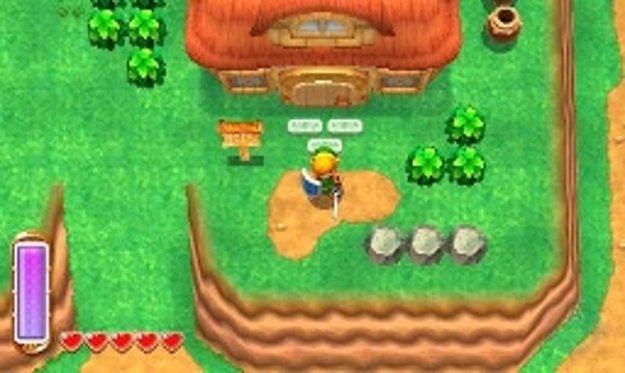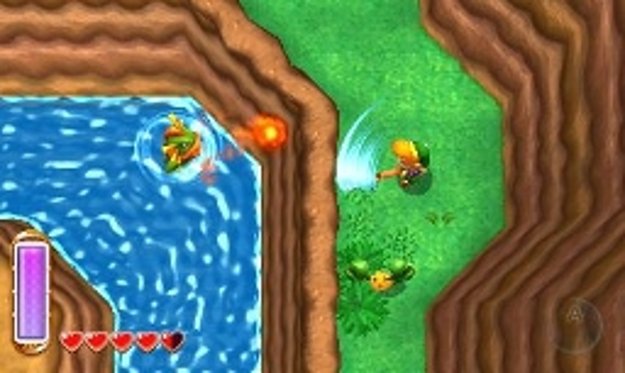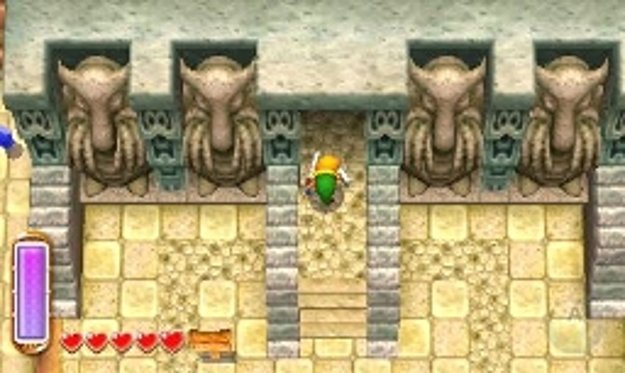If you've been a Zelda fan since Ocarina of Time, you're not going to like what I'm about to say. 3D Zelda is horribly overrated. I've always found the 3D titles like Ocarina, Majora's Mask, Twilight Princess and Skyward Sword to be boring, linear slogs built around singular gimmicks that always presented new dungeons based around a single item that was never used again and rarely deviated from that formula. Sure, Ocarina of Time was way ahead of it's time in terms of 3D game design when it was originally released in the late '90s and Wind Waker had a charming art style that kept things light hearted, but no game in the series has ever captured my attention like the original NES Legend of Zelda or one of the greatest games of all time, the Super Nintendo's Link to the Past.

A Link Between Worlds is the Zelda franchise's own link to its past. The game is the first official sequel to the SNES game, but this title straddles the line between remake and sequel. Much like the beloved SNES classic, this new game features a nearly identical overworld map, and a storyline that's pretty much cut and pasted from most Zelda games. An evil wizard has found a way to turn Hyrule royalty into possessed paintings in order to gain their magical powers for himself. Things get real when he manages to imprison Princess Zelda into a painting. It's up to a new hero (who is dressed and named exactly like the old one) to go after this new villain, rescue Princess Zelda, and find out who is really pulling the strings behind this insidious plot. While the story is inconsequential at best and completely rehashed at worst, it's not going to be the storyline that keeps you huddled over your 3DS for hours on end. If you've played through Link to the Past, you already know how this ends.
Even the setup is almost identical to the SNES classic. You start off the game with minimal items and powers, which you'll supplement by collecting rupees and completing dungeons. The game begins in sunny Hyrule where you'll have to complete three dungeons and secure the famed Master Sword in order to take on the tougher challenges of the Dark World, known here as Lorule. Lorule is a dark mirror image of Hyrule, with much tougher enemies, trickier puzzles and seven dungeons to complete before one final assault on the main villain.

While many elements feel instantly familiar to veterans of Link to the Past, it's not long before players will start to cherish the ways that Link Between Worlds forges its own path. For one, the game is far more open than any Zelda game since the original NES title. Most dungeons can be completed in any order the player chooses, and side quests feel organically included in standard exploration. Veterans will be excited to find certain items in the same places they were before, but the game constantly throws clever twists at the player long before it starts using nostalgia as a crutch.
Instead of finding key items in dungeons that are usually used in said dungeon and never again afterwards, this Zelda introduces an item rental system that opens up most of the game's items within the first hour of play. The catch is that while renting items, you'll keep them until you fall in battle, after which you'll have to trek back to Link's house to rent the items again. For the items that players use the most, you'll be given the option to simply buy the item at exorbitant costs between 800-1200 rupees, a far cry from the usual 80-100 rupee rental costs. This system creates a great balancing act where players can prioritize their favorite items to their play styles, while also encouraging players to explore the overworld map while collecting every rupee they can get their hands on. Once items are purchased, they can also be upgraded by finding hidden creatures through the game world and returning them to their worried mother. The only downfall of the system is that you can prevent yourself from losing your rented items by quickly switching the system power off when you die. If you want to cheat, that's your business.
The other major new change (gimmick?) to the standard Zelda tropes is the Link's new ability to become a two-dimensional painting to become flush against wall. This ability is used to ingenious effect throughout the game. At its most basic level, the painting ability lets Link traverse portals in between Hyrule and Lorule, bypass obstacles and avoid enemy attacks. Like every other major item in the game, using the ability drains magical power (that regenerates on its own). There's more than a few tense moments where the level designers gave just enough time/magical power to traverse long chasms. The most creative uses of this new power are rather ingenious and clever.
The dungeons themselves are fun and challenging while rarely veering into frustrating territory. Each one has a unique theme that stands apart from all the others, creating a strong sense of excitement of what's to come in the player. Most bosses will be familiar to LttP veterans, but even these feature enough clever winks and designs to feel nostalgic without even approaching a feeling of "been there, done that."

Another fun addition to the game is the ability to battle with Shadow Links that invade your game world through Street Pass. As you pass other 3DS players in your travels in the real world, the game will generate a Shadow Link for you to do battle with. If you survive the encounter, you'll gain a rupee bounty that can be used towards upgrades and new items.
In terms of audio/visual presentation, A Link Between Worlds shines. The game looks sharp and is fantastically animated. New and returning enemies alike ooze personality while still unmistakably leaning heavily on nostalgia. The environments that were once only visible on a 2D plane on the Super Nintendo have been completely modelled in 3D while retaining the top down view point of classic Zelda. Even using the 3D effects on the 3DS' screen creates outstanding depth of field effects that looked great throughout gameplay. The cutscenes may look a little cheesy and don't have any voice acting, but they're few and far between enough to make players appreciate using their imaginations. The music in the game is simply wonderful, with a perfect balance between remixed compositions from past games, with some great new tracks to complement the list.

A Link Between Worlds is simply a game that every 3DS owner should try out. Its a near perfect blend of puzzle solving, exploration, addictive action in a beautifully realized setting. This is a killer app for the incredibly popular 3DS, and it's my new personal favorite on the handheld that is quickly burgeoning with excellent titles. Seriously, it's worth buying 3DS hardware just for this game. Take it from someone who got their Zelda start with the original golden NES cartridge and spent countless childhood hours drawing maps and figuring out the game's dark secrets; after all these years, after so many acclaimed games and titles, I can truly say with a straight face that Zelda has never been better.